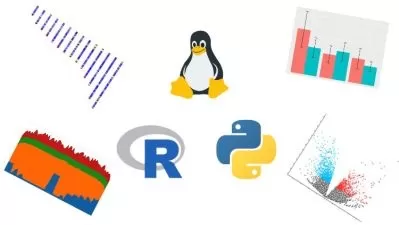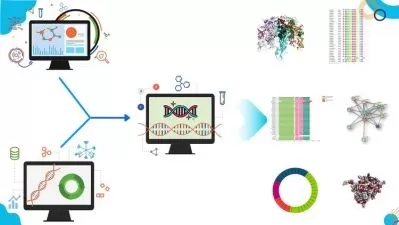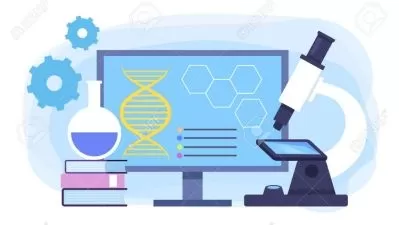Master Pipeline Development for Sequencing Reads Assembly
Abdul Rehman Ikram
3:15:23
Description
Master Genome Assembly Techniques: From Short and Long Read Sequencing to Linux Essentials for Bioinformatics
What You'll Learn?
- Understand the fundamental concepts and importance of genome assembly in genomics research.
- Gain knowledge about the historical evolution and advancements in genome assembly techniques.
- Learn about various genome assembly algorithms, including De Bruijn graphs, Overlap-Layout-Consensus, and string graphs.
- Become familiar with popular genome assembly tools such as SPAdes and Flye.
- Understand the principles and technology behind short read sequencing, particularly Illumina sequencing.
- Recognize the advantages and limitations of short read sequencing.
- Gain insights into long read sequencing technologies like PacBio and Oxford Nanopore.
- Understand the benefits and challenges associated with long read sequencing.
- Learn how to select the appropriate sequencing technology based on project goals, read length, accuracy, and cost.
- Compare different sequencing platforms and their applications.
- Develop proficiency in using commonly used Linux commands for file system navigation and management.
- Gain hands-on experience with essential Linux commands.
- Learn how to install bioinformatics tools on Linux and manage software dependencies.
- Gain practical skills in setting up bioinformatics tools and environments.
- Learn how to access and download short read data from public databases like NCBI SRA.
- Understand how to assess the quality of short reads using tools like FastQC.
- Understand the importance of read trimming in data preprocessing.
- Develop a step-by-step understanding of assembling short reads into contigs and scaffolds.
- Gain knowledge of using Anaconda for managing bioinformatics tools and environments.
- Develop a comprehensive understanding of assembling long reads and learn post-assembly processing, assembly polishing, and quality assessment techniques.
Who is this for?
What You Need to Know?
More details
DescriptionUnlock the power of genome assembly with our comprehensive course, "Master Pipeline Development for Sequencing Reads Assembly." This course is meticulously designed to guide you through the essential concepts and practical skills required for genome assembly, utilizing both short and long read sequencing technologies. Whether you are a beginner or a seasoned professional in the field of bioinformatics, this course will equip you with the tools and knowledge to excel.
What You'll Learn:
Introduction to Genome Assembly: Understand the fundamental concepts and importance of genome assembly in genomics research. Explore the historical evolution and advancements in genome assembly techniques.
Genome Assembly Algorithms and Tools: Dive deep into various genome assembly algorithms, including De Bruijn graphs, Overlap-Layout-Consensus, and string graphs. Get hands-on experience with popular tools like SPAdes, Canu, Flye, and ABySS.
Short Read Sequencing: Learn the principles and technology behind short read sequencing, particularly Illumina sequencing. Understand the advantages and limitations of short read sequencing.
Long Read Sequencing: Gain insights into long read sequencing technologies like PacBio and Oxford Nanopore. Understand the benefits and challenges associated with long read sequencing.
Choosing the Right Sequencing Technology: Learn how to select the appropriate sequencing technology based on project goals, read length, accuracy, and cost. Compare different sequencing platforms and their applications.
Linux Essentials for Bioinformatics: Develop proficiency in using Linux for bioinformatics tasks. Gain hands-on experience with essential Linux commands, installing bioinformatics tools, and managing software dependencies.
Short Read Sequencing Pipeline: Master the process of downloading, assessing, trimming, and assembling short read data. Learn to visualize genome assemblies using tools like Bandage and IGV.
Long Read Sequencing Pipeline: Learn to retrieve, assess, trim, and assemble long read data. Gain practical skills in using Anaconda for tool management and understand post-assembly processing and quality assessment techniques.
Who Should Enroll:
Bioinformatics enthusiasts eager to learn about genome assembly and sequencing technologies.
Students and researchers in biology, bioinformatics, and computational biology looking to enhance their practical skills.
Biologists and genomics scientists seeking hands-on experience with bioinformatics tools.
Computer scientists and data analysts wanting to apply their skills to biological data and genomics research.
Industry professionals in biotech and pharmaceutical sectors who require knowledge of genome assembly pipelines.
Beginners in bioinformatics who want a comprehensive introduction to genome assembly and sequencing data analysis.
Course Requirements:
Basic understanding of biology and genomics.
Basic computer skills and familiarity with operating a computer.
Access to a computer with an internet connection.
Enthusiasm for learning bioinformatics and applying computational methods to biological data.
No prior programming experience required; all necessary training will be provided.
Why Choose This Course:
Our course offers a blend of theoretical knowledge and practical skills, ensuring you gain a thorough understanding of genome assembly processes. With step-by-step instructions, hands-on exercises, and real-world applications, you'll be well-prepared to implement genome assembly techniques in your research or career. Join us to unlock new opportunities in the dynamic field of bioinformatics!
Enroll now and take the first step towards mastering genome assembly and sequencing data analysis.
Who this course is for:
- Individuals interested in the field of bioinformatics and eager to learn about genome assembly and sequencing technologies.
- Undergraduate and graduate students in biology, bioinformatics, computational biology, or related fields who want to enhance their practical skills in genome assembly.
- Researchers who need to analyze sequencing data and assemble genomes as part of their studies or projects.
- Professionals working in biological sciences and genomics who wish to gain hands-on experience with bioinformatics tools and techniques for genome assembly.
- Individuals with a background in computer science or data analysis looking to apply their skills to biological data and genomics research.
- Employees in biotech and pharmaceutical industries who require knowledge of genome assembly pipelines and bioinformatics tools for their work.
- Anyone new to bioinformatics who wants a comprehensive introduction to genome assembly, sequencing technologies, and the use of Linux for bioinformatics tasks.
Unlock the power of genome assembly with our comprehensive course, "Master Pipeline Development for Sequencing Reads Assembly." This course is meticulously designed to guide you through the essential concepts and practical skills required for genome assembly, utilizing both short and long read sequencing technologies. Whether you are a beginner or a seasoned professional in the field of bioinformatics, this course will equip you with the tools and knowledge to excel.
What You'll Learn:
Introduction to Genome Assembly: Understand the fundamental concepts and importance of genome assembly in genomics research. Explore the historical evolution and advancements in genome assembly techniques.
Genome Assembly Algorithms and Tools: Dive deep into various genome assembly algorithms, including De Bruijn graphs, Overlap-Layout-Consensus, and string graphs. Get hands-on experience with popular tools like SPAdes, Canu, Flye, and ABySS.
Short Read Sequencing: Learn the principles and technology behind short read sequencing, particularly Illumina sequencing. Understand the advantages and limitations of short read sequencing.
Long Read Sequencing: Gain insights into long read sequencing technologies like PacBio and Oxford Nanopore. Understand the benefits and challenges associated with long read sequencing.
Choosing the Right Sequencing Technology: Learn how to select the appropriate sequencing technology based on project goals, read length, accuracy, and cost. Compare different sequencing platforms and their applications.
Linux Essentials for Bioinformatics: Develop proficiency in using Linux for bioinformatics tasks. Gain hands-on experience with essential Linux commands, installing bioinformatics tools, and managing software dependencies.
Short Read Sequencing Pipeline: Master the process of downloading, assessing, trimming, and assembling short read data. Learn to visualize genome assemblies using tools like Bandage and IGV.
Long Read Sequencing Pipeline: Learn to retrieve, assess, trim, and assemble long read data. Gain practical skills in using Anaconda for tool management and understand post-assembly processing and quality assessment techniques.
Who Should Enroll:
Bioinformatics enthusiasts eager to learn about genome assembly and sequencing technologies.
Students and researchers in biology, bioinformatics, and computational biology looking to enhance their practical skills.
Biologists and genomics scientists seeking hands-on experience with bioinformatics tools.
Computer scientists and data analysts wanting to apply their skills to biological data and genomics research.
Industry professionals in biotech and pharmaceutical sectors who require knowledge of genome assembly pipelines.
Beginners in bioinformatics who want a comprehensive introduction to genome assembly and sequencing data analysis.
Course Requirements:
Basic understanding of biology and genomics.
Basic computer skills and familiarity with operating a computer.
Access to a computer with an internet connection.
Enthusiasm for learning bioinformatics and applying computational methods to biological data.
No prior programming experience required; all necessary training will be provided.
Why Choose This Course:
Our course offers a blend of theoretical knowledge and practical skills, ensuring you gain a thorough understanding of genome assembly processes. With step-by-step instructions, hands-on exercises, and real-world applications, you'll be well-prepared to implement genome assembly techniques in your research or career. Join us to unlock new opportunities in the dynamic field of bioinformatics!
Enroll now and take the first step towards mastering genome assembly and sequencing data analysis.
Who this course is for:
- Individuals interested in the field of bioinformatics and eager to learn about genome assembly and sequencing technologies.
- Undergraduate and graduate students in biology, bioinformatics, computational biology, or related fields who want to enhance their practical skills in genome assembly.
- Researchers who need to analyze sequencing data and assemble genomes as part of their studies or projects.
- Professionals working in biological sciences and genomics who wish to gain hands-on experience with bioinformatics tools and techniques for genome assembly.
- Individuals with a background in computer science or data analysis looking to apply their skills to biological data and genomics research.
- Employees in biotech and pharmaceutical industries who require knowledge of genome assembly pipelines and bioinformatics tools for their work.
- Anyone new to bioinformatics who wants a comprehensive introduction to genome assembly, sequencing technologies, and the use of Linux for bioinformatics tasks.
User Reviews
Rating
Abdul Rehman Ikram
Instructor's Courses
Udemy
View courses Udemy- language english
- Training sessions 24
- duration 3:15:23
- Release Date 2024/07/24










